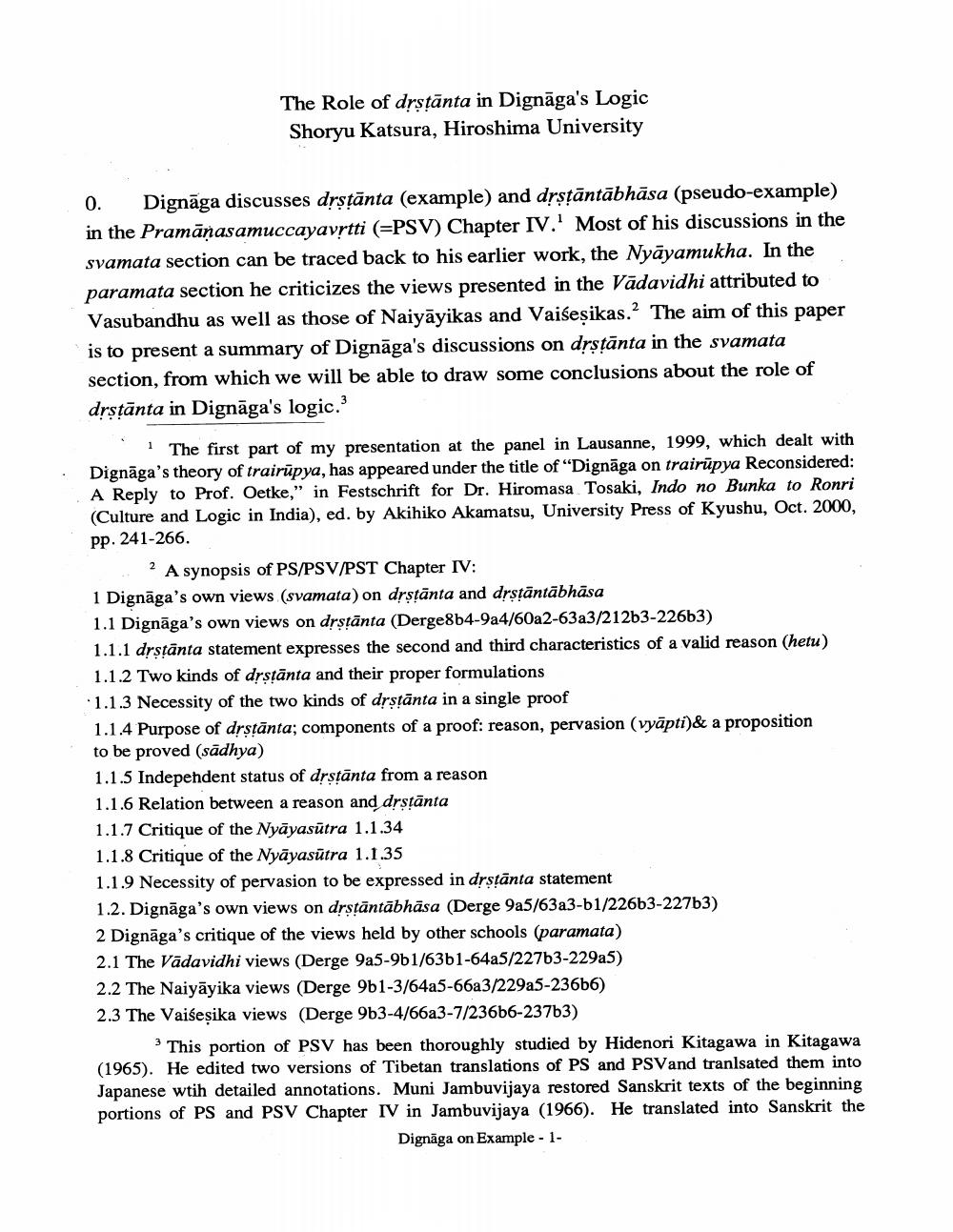Book Title: Role Of Drstanta Indignagas Logic Author(s): Shoryu Katsura Publisher: Shoryu Katsura View full book textPage 1
________________ The Role of drstänta in Dignäga's Logic Shoryu Katsura, Hiroshima University 0. Dignaga discusses drṣtänta (example) and drṣtäntäbhāsa (pseudo-example) in the Pramanasamuccayavṛtti (=PSV) Chapter IV. Most of his discussions in the svamata section can be traced back to his earlier work, the Nyayamukha. In the paramata section he criticizes the views presented in the Vädavidhi attributed to Vasubandhu as well as those of Naiyayikas and Vaisesikas.2 The aim of this paper is to present a summary of Dignaga's discussions on drstänta in the svamata section, from which we will be able to draw some conclusions about the role of drstanta in Dignaga's logic." The first part of my presentation at the panel in Lausanne, 1999, which dealt with Dignaga's theory of trairapya, has appeared under the title of "Dignaga on trairüpya Reconsidered: A Reply to Prof. Oetke," in Festschrift for Dr. Hiromasa Tosaki, Indo no Bunka to Ronri (Culture and Logic in India), ed. by Akihiko Akamatsu, University Press of Kyushu, Oct. 2000, pp. 241-266. 2A synopsis of PS/PSV/PST Chapter IV: 1 Dignaga's own views (svamata) on drstänta and drṣtäntäbhäsa 1.1 Dignaga's own views on dṛṣṭānta (Derge8b4-9a4/60a2-63a3/212b3-226b3) 1.1.1 dṛṣṭānta statement expresses the second and third characteristics of a valid reason (hetu) 1.1.2 Two kinds of dṛṣṭanta and their proper formulations 1.1.3 Necessity of the two kinds of dṛṣṭanta in a single proof 1.1.4 Purpose of drstanta; components of a proof: reason, pervasion (vyāpti)& a proposition to be proved (sädhya) 1.1.5 Independent status of dṛṣṭānta from a reason 1.1.6 Relation between a reason and drṣṭānta 1.1.7 Critique of the Nyayasutra 1.1.34 1.1.8 Critique of the Nyayasutra 1.1.35 1.1.9 Necessity of pervasion to be expressed in dṛṣṭänta statement 1.2. Dignaga's own views on dṛṣṭāntābhāsa (Derge 9a5/63a3-b1/226b3-22763) 2 Dignaga's critique of the views held by other schools (paramata) 2.1 The Vädavidhi views (Derge 9a5-9b1/63b1-64a5/227b3-229a5) 2.2 The Naiyayika views (Derge 9b1-3/64a5-66a3/229a5-236b6) 2.3 The Vaiseṣika views (Derge 9b3-4/66a3-7/236b6-237b3) 3 This portion of PSV has been thoroughly studied by Hidenori Kitagawa in Kitagawa (1965). He edited two versions of Tibetan translations of PS and PSV and tranlsated them into Japanese wtih detailed annotations. Muni Jambuvijaya restored Sanskrit texts of the beginning portions of PS and PSV Chapter IV in Jambuvijaya (1966). He translated into Sanskrit the Dignaga on Example - 1Page Navigation
1 2 3 4 5 6 7 8 9 10 11 12 ... 24
